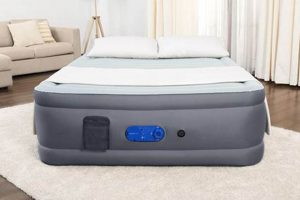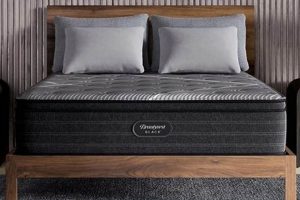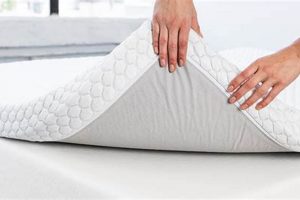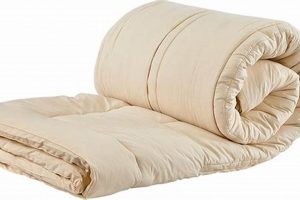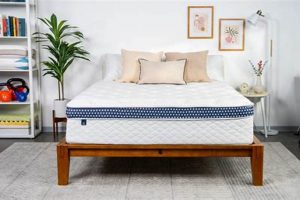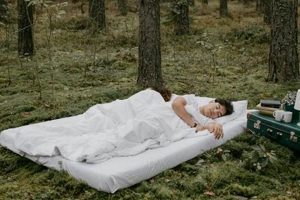A supportive and comfortable sleep surface tailored to the needs of older adults is a critical component of healthy aging. This type of bedding aims to alleviate pressure points, provide adequate spinal alignment, and facilitate ease of movement in and out of bed. For example, a mattress designed with zoned support could offer firmer support under the hips and softer support under the shoulders, contributing to better posture during sleep.
The significance of a suitable sleep surface for older individuals lies in its potential to improve sleep quality, reduce pain, and enhance overall well-being. Historically, older adults may have had limited options for specialized mattresses. However, increased awareness of age-related physical changes has led to advancements in mattress technology, resulting in a wider array of choices designed to address the specific comfort and support requirements of this demographic. The benefits extend beyond mere comfort; appropriate support can contribute to improved circulation, reduced risk of pressure ulcers, and enhanced independence.
The following discussion will delve into the key considerations when selecting a sleep surface, examining factors such as mattress type, firmness levels, materials, and specific features that cater to the unique needs of seniors. This will include an overview of various options, including memory foam, latex, and hybrid models, along with advice on evaluating features like edge support, temperature regulation, and motion isolation to promote restful and restorative sleep.
Considerations for Selecting an Appropriate Sleep Surface
Choosing a suitable sleep surface requires careful evaluation to address the specific needs of older adults. The following tips provide guidance on navigating the selection process.
Tip 1: Evaluate Firmness Level: Assess the appropriate firmness based on individual weight, sleeping position, and any existing medical conditions. A medium-firm option generally offers a balance of support and pressure relief, but adjustments may be necessary to accommodate individual requirements.
Tip 2: Prioritize Pressure Relief: Select a mattress with materials known for their ability to contour to the body and alleviate pressure points. Memory foam and latex are commonly used for this purpose, but consider the density and composition to ensure optimal comfort.
Tip 3: Examine Edge Support: Adequate edge support is crucial for stability and ease of movement when getting in and out of bed. Reinforced edges can prevent sagging and provide a secure surface for sitting.
Tip 4: Investigate Mattress Type: Different mattress types, such as innerspring, memory foam, latex, and hybrid, offer varying levels of support, comfort, and durability. Research the characteristics of each type to determine the most suitable option.
Tip 5: Consider Temperature Regulation: Temperature regulation is essential for maintaining a comfortable sleep environment. Look for mattresses with breathable materials and cooling technologies to prevent overheating during the night.
Tip 6: Assess Motion Isolation: If sharing a bed, motion isolation is an important consideration. Mattresses with good motion isolation minimize the transfer of movement, allowing for undisturbed sleep.
Tip 7: Factor in Ease of Cleaning: Opt for a mattress with a removable, washable cover to facilitate cleaning and maintenance. This helps to keep the sleep surface hygienic and extend its lifespan.
By carefully considering these factors, individuals can make an informed decision and select a sleep surface that promotes comfortable, restful, and supportive sleep.
The subsequent sections of this article will address common misconceptions and explore additional strategies for optimizing the sleep environment.
1. Pressure Relief
Pressure relief, in the context of sleep surfaces for older adults, refers to the mattress’s capacity to minimize concentrated force on specific areas of the body, such as the hips, shoulders, and back. The connection between pressure relief and an appropriate mattress is paramount due to the increased prevalence of joint pain, arthritis, and reduced skin elasticity among older individuals. Inadequate pressure relief can exacerbate existing pain conditions, impede blood circulation, and increase the risk of pressure ulcers. For instance, an older person with hip arthritis may experience significant discomfort on a firm mattress that creates high-pressure points, whereas a mattress with effective pressure relief distributes weight more evenly, alleviating pain and promoting better sleep.
Mattresses achieve pressure relief through various materials and construction techniques. Memory foam, for instance, contours to the body’s shape, effectively distributing weight and reducing pressure points. Latex mattresses offer a similar effect with a more responsive feel. Zoned mattresses, which feature varying levels of firmness across different sections, provide targeted support and pressure relief. The selection of a mattress that prioritizes pressure relief has practical significance in enhancing sleep quality, reducing pain medication reliance, and improving mobility for older adults. Consider an individual recovering from a hip replacement; a supportive mattress engineered for pressure relief could significantly improve recovery and comfort during sleep.
In summary, the role of pressure relief cannot be overstated when assessing sleep surfaces for older adults. By reducing concentrated forces on sensitive areas, these mattresses contribute to pain reduction, improved circulation, and a decreased risk of pressure sores. Overlooking pressure relief could undermine the entire effort to find a supportive and comfortable sleep environment. Understanding the benefits and practical applications of adequate pressure relief is critical for informed decision-making and ultimately enhancing the quality of life for older adults.
2. Spinal Alignment
Maintaining proper spinal alignment during sleep is essential for overall health and well-being, particularly for older adults. The connection between spinal alignment and a suitable sleep surface lies in the mattress’s ability to support the natural curvature of the spine. A mattress that fails to provide adequate support can lead to misalignment, resulting in back pain, muscle stiffness, and potential nerve compression. This issue is compounded in older adults due to age-related changes such as decreased muscle mass, reduced bone density, and increased susceptibility to degenerative disc disease. For example, an individual with osteoporosis may experience heightened pain and discomfort on a mattress that lacks sufficient support, forcing the spine into an unnatural position throughout the night. The importance of spinal alignment cannot be overstated; a well-aligned spine promotes optimal nerve function
, reduces strain on joints, and facilitates restful sleep. A mattress designed to maintain this alignment is a key component of a sleep environment that supports healthy aging.
Different mattress types offer varying degrees of spinal support. Memory foam and latex mattresses conform to the body’s contours, providing customized support that helps maintain proper alignment. Innerspring mattresses, while offering firm support, may not always conform adequately to the body’s natural curves, potentially leading to misalignment. Hybrid mattresses, which combine features of both memory foam/latex and innerspring designs, can offer a balance of support and contouring. Furthermore, adjustable beds allow users to customize the angle of the mattress, providing additional support and facilitating spinal alignment in various sleeping positions. A practical application of this understanding involves selecting a mattress with appropriate firmness based on individual needs and sleeping positions. Side sleepers, for instance, may benefit from a softer mattress that allows the shoulder and hip to sink in, maintaining spinal alignment. Back sleepers, on the other hand, may require a firmer mattress to prevent the hips from sinking too far, causing lower back strain.
In conclusion, the relationship between spinal alignment and a well-chosen sleep surface is critical for promoting comfort, reducing pain, and supporting overall health in older adults. Ignoring the importance of spinal alignment can lead to chronic back pain, compromised mobility, and reduced quality of life. While selecting the appropriate mattress can be challenging, focusing on materials, firmness levels, and adjustability features designed to support the natural curvature of the spine is paramount. Understanding the practical significance of spinal alignment in the context of mattress selection empowers individuals to make informed decisions that contribute to healthier and more restful sleep.
3. Edge Support
Edge support refers to the structural reinforcement along the perimeter of a mattress, designed to prevent sagging and provide a stable surface for sitting or lying near the edge. The connection between robust edge support and a suitable mattress for older adults is significant due to its impact on safety, accessibility, and independence. Diminished mobility and balance issues often make exiting or entering bed a challenging task for elderly individuals. A mattress with weak edge support can cause the sleeper to slide off the edge, increasing the risk of falls and injuries. Furthermore, if an individual relies on the edge of the mattress for support while standing or transferring to a mobility device, inadequate edge support can compromise stability. A practical illustration involves an older adult recovering from surgery; a mattress with firm edge support could provide the necessary stability and confidence to safely get in and out of bed, facilitating their recovery process.
Various mattress construction techniques contribute to effective edge support. Reinforced coils, high-density foam encasements, and strategically placed support bars are common features used to strengthen the perimeter. The type of mattress material also plays a role. For instance, innerspring mattresses often incorporate reinforced coils around the edges, while foam mattresses may utilize denser foam around the perimeter to prevent compression. Hybrid mattresses can combine both methods for enhanced stability. The choice of materials and design directly affects the longevity and effectiveness of the edge support, impacting the overall usability of the mattress. Consider an individual with limited upper body strength; a mattress with a strong, stable edge allows them to push off with their hands more effectively, making it easier to sit up and swing their legs over the side.
In conclusion, the role of edge support in a suitable mattress for older adults extends beyond mere comfort. It directly impacts safety, accessibility, and the ability to maintain independence. The absence of adequate edge support can increase the risk of falls and make everyday tasks more difficult. While selecting a mattress, the presence and quality of edge support should be a primary consideration, ensuring it aligns with the individual’s mobility needs and physical capabilities. By prioritizing this feature, individuals can contribute to a safer and more supportive sleep environment, promoting overall well-being and enhancing the quality of life for older adults.
4. Motion Isolation
Motion isolation, in the context of a sleep surface, refers to the mattress’s ability to minimize the transfer of movement across its surface. The connection between motion isolation and a suitable mattress for older adults is significant, particularly when the individual shares a bed with a partner. Sleep disturbances caused by a partner’s movements, such as tossing, turning, or getting in and out of bed, can negatively impact sleep quality. The need for undisturbed sleep is paramount for older individuals, as their sleep cycles are often more fragile and susceptible to disruption. For example, an elderly person with insomnia may find it particularly challenging to fall back asleep after being awakened by their partner’s movements on a mattress that lacks adequate motion isolation. Consequently, selecting a mattress with effective motion isolation can contribute to more restful and restorative sleep for both individuals.
Mattresses achieve motion isolation through various materials and construction techniques. Memory foam and latex are known for their ability to absorb movement and prevent it from spreading across the surface. Individually pocketed coils, also known as encased coils, function independently, reducing motion transfer compared to traditional innerspring systems. Hybrid mattresses, which combine pocketed coils with a comfort layer of memory foam or latex, offer a balanced approach to both support and motion isolation. Practical applications of this understanding involve evaluating mattress specifications and materials to determine the degree of motion isolation provided. For instance, an older individual sharing a bed with a restless sleeper would benefit from a mattress with a high density memory foam comfort layer over individually pocketed coils, effectively minimizing motion transfer and promoting uninterrupted sleep.
In summary, the connection between motion isolation and selecting a suitable mattress for older adults lies in its potential to mitigate sleep disturbances caused by a partner’s movements. Compromised sleep quality can exacerbate existing health conditions and reduce overall well-being. Therefore, motion isolation should be a primary consideration for older adults sharing a bed. While various mattress types offer motion isolation capabilities, careful evaluation of materials and construction techniques is essential to ensure the selected mattress effectively minimizes motion transfer and promotes restful sleep for both bed partners. Addressing motion isolation challenges enhances the sleep environment and can contribute significantly to the health and quality of life for older individuals.
5. Temperature Regulation
Temperature regulation, with respect to mattresses designed for older adults, denotes the
capacity of the sleep surface to maintain a consistent and comfortable temperature throughout the night. The connection between effective temperature regulation and a suitable mattress for the elderly is critical due to the increased prevalence of thermoregulation challenges associated with aging. Physiological changes, such as decreased subcutaneous fat and reduced metabolic rate, can impair the body’s ability to maintain a stable core temperature, leading to overheating or feeling cold during sleep. This discomfort can disrupt sleep cycles and exacerbate existing health conditions. For instance, an elderly individual experiencing hot flashes may find that a mattress lacking adequate temperature regulation intensifies their discomfort, leading to fragmented sleep. Therefore, a mattress engineered to promote airflow and dissipate heat is essential for creating a comfortable and restorative sleep environment.
Mattresses achieve temperature regulation through a combination of materials and design. Breathable fabrics, such as cotton or bamboo, allow air to circulate, preventing heat buildup. Open-cell foam structures, as opposed to closed-cell designs, promote greater airflow within the mattress core. Cooling gels or phase-change materials can be incorporated into the comfort layers to absorb and release heat, maintaining a consistent surface temperature. Practical applications of this understanding involve carefully evaluating mattress specifications to identify features that enhance temperature regulation. An individual prone to night sweats, for example, would benefit from a mattress constructed with breathable materials, open-cell foam, and a cooling gel infusion. Furthermore, the type of bedding used in conjunction with the mattress, such as lightweight sheets and blankets, can also contribute to effective temperature management.
In conclusion, the importance of temperature regulation in a suitable mattress for older adults stems from the need to mitigate age-related thermoregulation challenges and promote restful sleep. Disrupted sleep caused by temperature fluctuations can negatively impact overall health and well-being. While selecting a mattress, attention should be paid to materials, construction techniques, and cooling technologies designed to maintain a consistent and comfortable sleep environment. Failing to address temperature regulation issues can undermine the effectiveness of other supportive features, such as pressure relief and spinal alignment. Therefore, integrating temperature regulation considerations into the mattress selection process is essential for enhancing the sleep quality and overall comfort of older adults.
6. Ease of Access
Ease of access, when considering a suitable sleep surface, relates to the simplicity and safety with which an individual can get into and out of bed. A direct correlation exists between ease of access and an optimal sleep surface. Mobility limitations, common among older adults, necessitate careful consideration of bed height, edge support, and overall mattress stability. A bed that is too high or too low can pose significant challenges, increasing the risk of falls and hindering independence. For example, an individual with arthritis may struggle to climb onto a high mattress, while a mattress positioned too close to the floor may require excessive bending, exacerbating joint pain. This aspect of accessibility is thus critically connected to the notion of “best mattress for elderly.”
Addressing ease of access involves considering the combined height of the mattress and bed frame. Adjustable bed frames allow for customization, enabling individuals to find a height that minimizes strain on joints and muscles. Sturdy edge support provides a stable surface for sitting and transferring, further enhancing safety. Another crucial element to consider is the environment of the room. Adequate lighting at the bedside or in the bedroom’s pathway enables safe movement to, from, and around the bed. Furthermore, grab bars or other assistive devices may need to be installed to provide additional support.
In summary, ease of access is a non-negotiable component of a beneficial sleep surface for elderly people, directly impacting their safety, comfort, and independence. The mattress selection process needs to include careful evaluation of height, stability, and the surrounding environment to ensure the bed promotes ease of movement and reduces the risk of falls. Overlooking this crucial element can lead to injuries, frustration, and a decreased quality of life.
7. Durability
Durability, concerning sleep surfaces tailored for older adults, refers to the mattress’s ability to maintain its original comfort and support characteristics over an extended period. The correlation between durability and the concept of an optimal sleep surface is significant due to the long-term investment and specific physical requirements involved. A mattress that degrades rapidly loses its capacity to provide adequate pressure relief, spinal alignment, and edge support. This degradation can exacerbate existing medical conditions and undermine the benefits initially sought. For example, an older individual with arthritis purchasing a memory foam mattress for pressure relief may experience diminished comfort and increased pain if the mattress loses its responsiveness and conforming ability within a short timeframe. The longevity of a mattress directly influences its overall value and its sustained contribution to the user’s well-being. The emphasis on durability highlights the economic and health-related implications of mattress selection for older individuals, extending beyond initial comfort to encompass years of consistent performance.
Several factors contribute to mattress durability. Material quality, construction techniques, and usage patterns all play a role. High-density foam, robust coil systems, and reinforced edges enhance a mattress’s structural integrity and resistance to wear and tear. Proper mattress rotation and the use of a protective mattress cover can mitigate factors that accelerate degradation, such as uneven weight distribution and exposure to moisture. Evaluating mattress warranties and conducting thorough research on brand reputation can provide valuable insights into expected lifespan and potential long-term performance. Consider the practical scenario of a senior living in assisted care. A durable mattress can withstand the rigors of frequent use, potential spills, and adjustments in sleeping positions, thereby providing reliable support and comfort over an extended period, minimizing the need for premature replacement.
In summary, the role of durability in a suitable mattress for older adults extends beyond mere longevity; it directly impacts the consistency of support, the sustained relief of pain, and the overall value derived from the investment. A lack of durability not only compromises the initial benefits but also necessitates more frequent replacements, resulting in increased costs and potential disruptions to sleep quality. Therefore, the careful consideration of material quality, construction techniques, and warranty provisions is critical when selecting a mattress intended to provide long-term comfort, support, and well-being for older individuals, ensuring the sleep surface remains conducive to restful and restorative sleep for years to come.
Frequently Asked Questions
The following addresses common inquiries regarding sleep surfaces for older adults, providing clarity on essential considerations.
Qu
estion 1: How does mattress firmness impact older adults?
Mattress firmness influences spinal alignment and pressure relief. A medium-firm mattress is generally recommended for balancing support and cushioning. However, individual needs may vary based on weight, sleeping position, and medical conditions. Consulting with a healthcare professional is advisable.
Question 2: What mattress type is most suitable for individuals with arthritis?
Memory foam and latex mattresses are often recommended due to their ability to contour to the body and alleviate pressure points. Zoned mattresses, with varying firmness levels, can offer targeted support for specific areas. Individual preferences should be considered during the selection process.
Question 3: What are the key features to consider for bedridden older adults?
Pressure relief, air circulation, and ease of cleaning are paramount. Low air loss mattresses can help prevent pressure ulcers. Waterproof and easily sanitized surfaces are essential for hygiene. Regular repositioning is still necessary even with specialized mattresses.
Question 4: How important is edge support?
Edge support is vital for safe entry and exit from the bed, particularly for individuals with mobility issues. It prevents sagging and provides a stable surface for sitting or transferring. Reinforced edges enhance overall stability and safety.
Question 5: How frequently should a mattress be replaced?
Mattress lifespan varies depending on material quality and usage, but a replacement every 7-10 years is generally recommended. Visible signs of wear, such as sagging or lumps, indicate the need for a replacement, even sooner. A decline in sleep quality can also indicate that the mattress is no longer providing adequate support.
Question 6: Can an adjustable bed frame enhance the benefits of this type of mattress?
Yes, an adjustable bed frame can improve comfort and circulation. Elevating the head and feet can alleviate pressure on the spine and improve breathing. Adjustable bases can be beneficial for individuals with reflux, sleep apnea, or mobility limitations.
In summary, the selection of an appropriate sleep surface requires careful consideration of individual needs and physical limitations. A healthcare professional can provide valuable guidance in determining the most suitable option.
The subsequent section will explore practical tips for optimizing the sleep environment to promote better sleep quality for elderly individuals.
Conclusion
The preceding discussion has provided a comprehensive analysis of the factors critical in selecting a “best mattress for elderly.” Key considerations such as pressure relief, spinal alignment, edge support, motion isolation, temperature regulation, ease of access, and durability are paramount in ensuring optimal comfort, safety, and support. A failure to address these elements can compromise sleep quality, exacerbate existing medical conditions, and diminish overall well-being. The optimal sleep surface must cater to the unique physiological changes and potential mobility limitations associated with aging.
The selection of a sleep surface represents a significant investment in long-term health and quality of life. A careful and informed decision, guided by an understanding of individual needs and the practical implications of various mattress features, is essential. Continued advancements in sleep technology offer the potential for further customization and optimization of sleep surfaces, providing enhanced support and comfort for older adults. It is imperative to prioritize these considerations to ensure a restful and restorative sleep experience.


